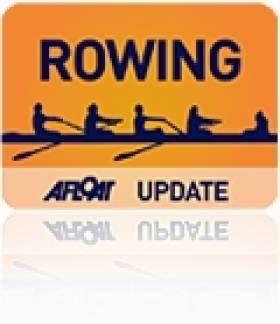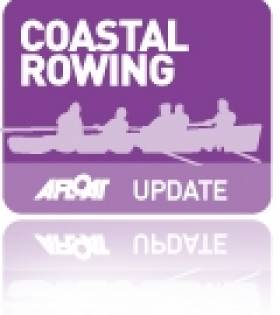Displaying items by tag: Great Pacific Race
Battleborn Reaches Shore In Hawaii in Great Pacific Race
#ROWING: Battleborn, skippered by Irishman Philip Cavanagh, has landed in Hawaii, completing the Great Pacific Race from Monterey in California in 45 days, seven hours and 24 minutes. The crew of Cavanagh, Britons Barry Hayes and Darren Taylor and Australian Dan Kierath were the second home in the race. Their boat, Patience, flew the Irish flag. They arrived in the early hours of the morning, Irish time. Among those waiting on shore were Philip’s parents, Carmel and Michael Cavanagh.
#oceanrower – British solo rower, Daryl Farmer, who was taking part in the Great Pacific Race rowing from California to Hawaii, was forced to call for assistance four days after beginning the race, having become dangerously dehydrated from sea sickness.
Support boat OPA located him and took Daryl and his boat 'Bojangles' (Bo) under tow on Saturday 21 June approximately 20nm off the coast of California. Heavy seas and high winds unfortunately snapped both ropes, leading to a dramatic man overboard situation for one of OPA's crew. This situation left them no choice but to transfer Daryl from his boat to OPA and return him to Monterey safely, but leaving Bo adrift.
39 year old Daryl, who took on the challenge of rowing 2400 miles single-handed from California to Hawaii to raise awareness of the need for ocean conservation, is now refusing to return to the UK until he is reunited with his boat. The race is now on to find her again and bring her back in - hopefully in one piece.
BOJANGLES – LAST KNOWN POSITION/DESCRIPTION
Marine traffic around Bo's last known position of 35 43' 38.40"N, 121 59' 23.4"W as of 00:01 PDT 23 June is being asked to keep a look out for the vessel and report any sighting immediately, using degrees, minutes, seconds format, to Peggy West-Stap on 831.901.3833.
Bo is 24ft x 6ft, silver cabins fore and aft; deck is light blue with 11 visible black circular hatch covers with red rim; there is also a yellow hi vis strip running in part across the bow and stern cabins. If inverted, she is black anti-fouled. She carries the #6 on port and starboard sides. There should be a steel light blue rudder attached.
SEARCH ASSISTANCE FROM FELLOW OCEAN CONSERVATIONISTS
Three marine conservation organisations are helping to coordinate the search for 'Bo'. Pete Bethune from Earthrace Conservation is coordinating GPS positions from his home in New Zealand; Peggy West-Stap from Monterey Bay Marine Life Studies is liaising with the US Coastguard and supplying local knowledge and support for Daryl and partner Sabine Grainger; Captain Chris Wade, who skippers Shark Boat Sea Watch, a shark research vessel that works with the Shark Research Institute, is en route to the search area from Los Angeles.
ABOUT BO
Bo is one of the strongest, most proven and sought-after ocean rowing boats in the world, made from a special carbon/Kevlar foam sandwich construction. She was built with the Pacific in mind and already in the record books as the first and only rowing boat to successfully complete a crossing of the Pacific West to East in 2009 with her crew of Mick Dawson and Chris Martin (Race Director for Great Pacific Race 2014).
Daryl said, "I'm heartbroken that I couldn't continue in the race and leaving Bo out there was the worst feeling in the world. I'm safe though, and want to say a huge and sincere thanks to the crew of OPA for braving those conditions to come and get me, a truly humbling experience for which I will be forever grateful. All I want to do now is find Bo and bring her home."
Dublin Woman to Row 2,400 Miles in Pacific Rowing Race
#rowing – On June 7, a doctor from Castleknock in Dublin will set off on a 2,400 mile rowing expedition from Monterey, California to Honolulu, Hawaii. Aoife Ní Mhaoileoin and her teammates, Emily Blagden, Laura Kennington and Ingrid Kvale, will be the first all-female four to complete the row, which will take over forty days.
'Team Boatylicious' is one of 15 crews participating in the inaugural Great Pacific Race, which the organisers describe as the "biggest, baddest human endurance challenge on the planet".
The team is raising money for two charities: Hope and Homes for Children, which works internationally to eradicate institutional care of children and The Ahoy Centre, which gives disadvantaged children and people with disabilities the opportunity to earn sailing qualifications.
"I'm drawn to the race as an opportunity to test all my physical and mental resources." Aoife says. Obviously it's a daunting prospect, particularly as I've never taken on a major rowing expedition before, but I can't wait to get out on the water in June.
"We are raising funds for two inspiring charities and we welcome donations to these causes. We're also inviting corporate sponsors to become part of the team by helping us to meet our race costs.
"We have been training intensely, as well as taking courses in sea survival and navigation. Beyond the physical and psychological training, there are also a huge number of practical considerations. We need to ensure that our boat is race ready and that we have reliable water-purifying equipment and plenty of food — we'll need to consume 5,000-6,000 calories a day!
"Less than three months out I am getting nervous, but if nothing else it's a great excuse for a holiday in Hawaii!"































































